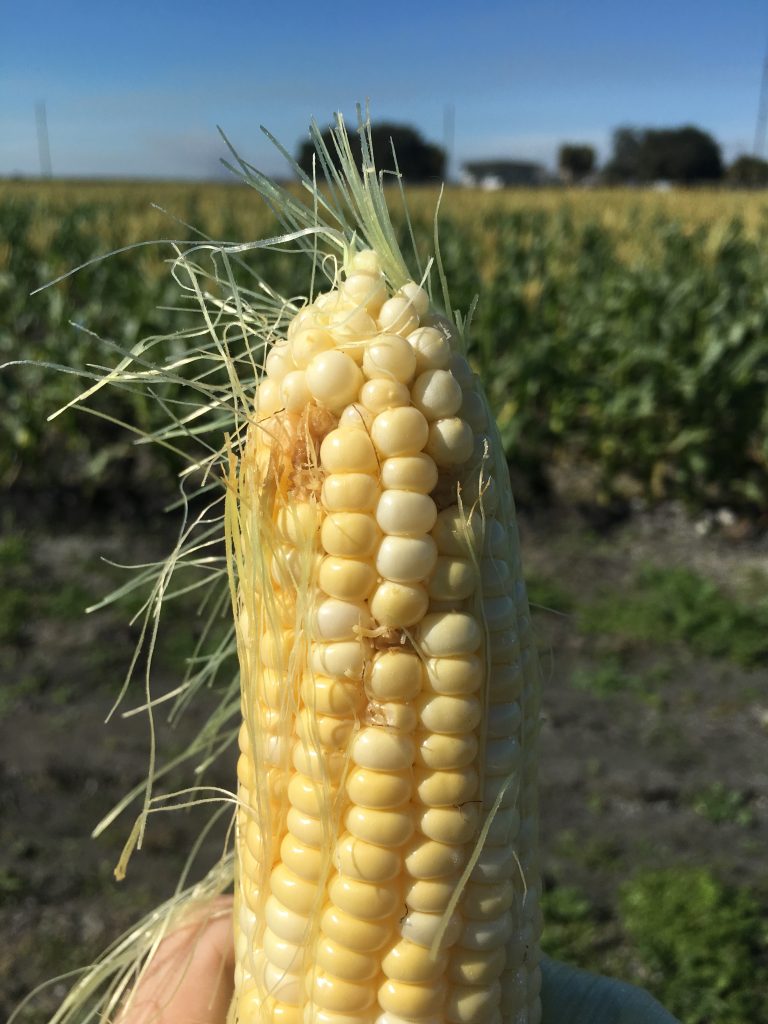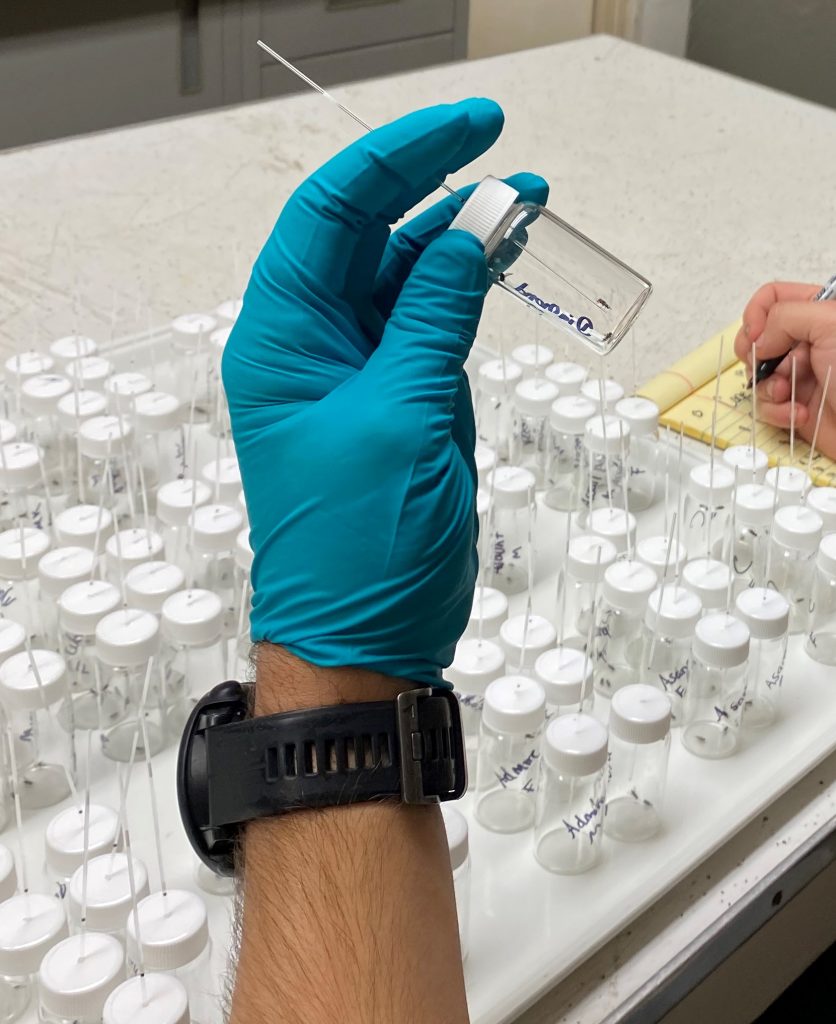
By Julien Beuzelin
Corn silk flies are the most damaging insects of sweet corn in southern Florida. Adults of three species(Euxesta stigmatias, Euxesta eluta and Chaetopsis massyla) are commonly observed in commercial fields where they lay eggs on sweet corn silks. Maggots feed on silks and kernels before leaving the ear and falling onto the soil surface, under which they pupate. Adults emerge from the soil ready to mate and lay eggs within days, thus completing the pest’s life cycle.
Corn silk fly maggot infestations and associated injury are responsible for crop losses every year, particularly in the spring. Losses occur because a small proportion of sweet corn loads might be rejected, but also because growers forgo harvest of portions of fields and sometimes entire fields when infestations are expected to lead to load rejections. These losses occur in spite of intensive pest management. In addition, corn silk flies have become increasingly challenging to manage over the past 20 years.
Research conducted at the University of Florida Institute of Food and Agricultural Sciences (UF/IFAS) has focused on determining why corn silk flies are challenging to control and on developing improved management tactics.
PYRETHROID RELIANCE AND SUSCEPTIBILITY
Pyrethroids have become the cornerstone of corn silk fly management because effective alternatives in other insecticide classes have been phased out. Chlorpyrifos, methomyl and spinetoram also play a role currently. However, chlorpyrifos, which might lose its registration in the near future, can only be applied at a reduced rate within 21 days of harvest when sweet corn is susceptible to flies. In addition, methomyl has limited residual activity, and spinetoram is extremely expensive. Thus, chlorpyrifos and methomyl are frequently co-applied with pyrethroids to increase efficacy, and spinetoram is seldom used.
Corn silk fly control is challenging because available insecticides are effective only if the insects are exposed to sprays or treated surfaces. Thus, only adults are the targets of management. Maggots and pupae are protected within ears and under the soil surface, respectively. Female adults escaping insecticide control or moving into sweet corn fields from adjacent habitats can lay eggs on susceptible ears, resulting in maggot infestations that cannot be further controlled.
Repeated use of a single insecticide mode of action may lead to the development of insecticide resistance in pest populations. Therefore, pyrethroid resistance is a concern and may contribute to difficulties in controlling corn silk flies.
Graduate student Eric Schwan Resende at the UF/IFAS Everglades Research and Education Center in Belle Glade has recently developedan adult vial assay for corn silk flies. This method involves coating the inner surface of small glass vials with a pyrethroid and introducing adults into the vials for 24 hours to record mortality as affected by different insecticide concentrations. It has been used to determine pyrethroid susceptibility for populations occurring in Florida sweet corn fields.
Seven corn silk fly populations collected in sweet corn fields of the Everglades Agricultural Area and Homestead region in 2020 were evaluated using beta-cyfluthrin as a representative pyrethroid. The LC50, which is the estimated concentration killing 50 percent of the population, was determined for each population.

Two E. stigmatias populations from non-treated experimental fields had LC50s of 0.4 and 0.8 microgram (µg) per vial. Four E. stigmatias populations from commercial fields had LC50s between 1.5 and 3.5 µg per vial. One E. eluta population from a commercial field had an LC50 of 0.2 µg per vial. In addition, one E. eluta population maintained in the laboratory and serving as susceptible reference had an LC50 of 0.02 µg per vial.
These results provide further evidence that E. eluta is more susceptible to pyrethroids than E. stigmatias. Thus, management should be more aggressive if E. stigmatias is present. Results suggest that E. stigmatias populations in non-treated fields are more susceptible to pyrethroids than populations in commercial fields that were intensively treated with insecticides. However, there is little variability in E. stigmatias pyrethroid susceptibility among populations in commercial fields. Thus, difficulties in controlling E. stigmatias are likely the result of high population levels, environmental conditions and the selection of less susceptible individuals in field populations.
THE SEARCH FOR ALTERNATIVES
Laboratory protocols were developed in 2020 to determine corn silk fly mortality associated with contact and ingestion exposure to insecticides including non-registered active ingredients. Preliminary experiments using E. eluta adults showed that whereas pyrethroids are effective via topical exposure, alternatives including neonicotinoids, diamides, abamectin and indoxacarb do not cause observable lethal effects. Via ingestion of insecticides at 1 percent of high field rates, the non-registered neonicotinoids thiamethoxam, clothianidin and dinotefuran caused 60 to 90 percent mortality.
Although results need to be confirmed, these experiments show that potential alternatives to pyrethroids are not effective via topical exposure. However, some neonicotinoids are effective via ingestion. Thus, these insecticides cannot be direct replacements for pyrethroids, but they should be considered with baits forcing corn silk fly ingestion of insecticides.
CONCLUSIONS
High levels of pyrethroid resistance do not appear to be the main reason why corn silk flies are extremely challenging to control under current sweet corn production conditions. However, observations suggest reduced susceptibility in commercial field populations. Thus, adult vial assays are a newly developed method that will be used routinely to test field populations and monitor for pyrethroid resistance.
With large corn silk fly populations building up, additional insecticides and new modes of insecticide delivery are needed. The use of baits and neonicotinoids have potential to control silk flies and will be further evaluated. In addition to insecticides, UF/IFAS entomologists will continue studying corn silk fly ecology, in particular the role of habitats adjacent to sweet corn fields to reduce or even prevent adult movement from adjacent crop and non-crop habitats.
Acknowledgments: Corn silk fly research is partially supported by Florida Department of Agriculture and Consumer Services Specialty Crop Block Grants. Crop consultants and Dak Seal (UF/IFAS Tropical Research and Education Center, Homestead) assisted with insect collections.
Julien Beuzelin is an assistant professor at the UF/IFAS Everglades Research and Education Center in Belle Glade.









